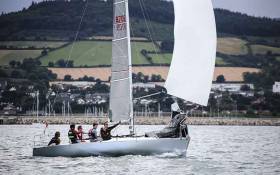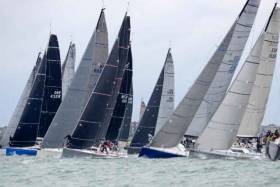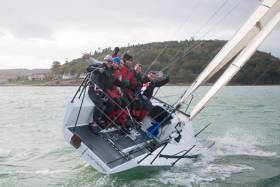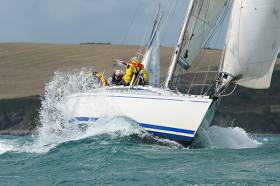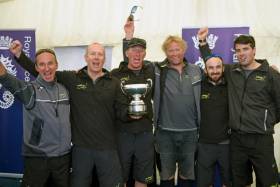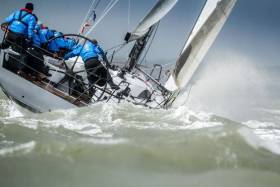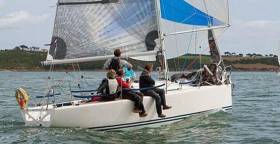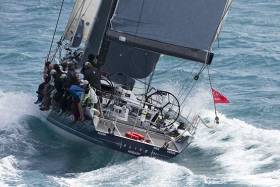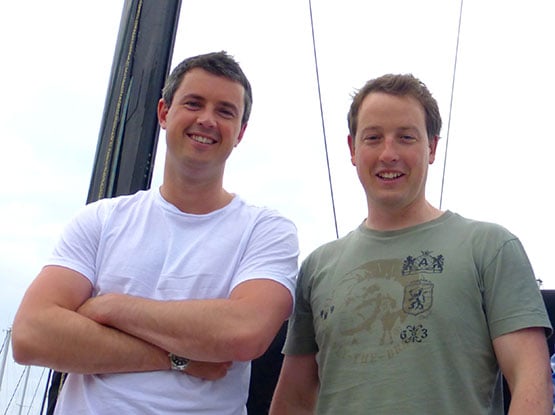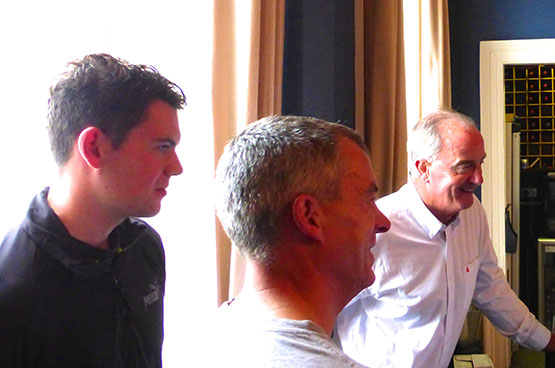Displaying items by tag: IRC
Smaller Boats Not Welcome at IRC Euros 2018?
The significance of the RORC decision to merge the Commodore's Cup with the IRC Europeans in 2018 has extra meaning for Ireland given at least half of the Irish fleet will not be eligible to race due to a ratings band change.
RORC has set a lower rating limit of 1.000 so that means, for example, first and second overall at the 2016 Europeans (Irish boats, Anchor Challenge and Harmony) will not be able to compete in 2018.
It is a vastly different situation to that which existed for the inaugural Euros at Cork Week 2016 and also this year's event in Marseilles. The 2017 event has a minimum limit of .900 allowing them this year.
Details of the 2018 event were published by Afloat.ie yesterday here.
Ireland's fleet has a lot of sub 1.000 boats, but particularly the growing Quarter and Half Ton classes.
Two of the strongest classes at the ICRA championships are class 2 and class 3 and effectively IRC organisers (UNCL and RORC) are not giving them a place at their own European championships.
No doubt this is something that will be addressed tomorrow at the ICRA conference in Limerick where RORC will be in attendance and can give an explanation.
'It appears RORC are trying to resurrect the dying Commodores Cup by attaching it to the IRC Europeans, and in so doing is telling smaller, often less wealthy owners, that they are now not interested in them, a leading Irish IRC racer told Afloat.ie'.
A change to a lower limit that at least includes the Half tonners would be to Ireland's advantage.
June 2018 will see the cream of the IRC fleet gather in the Solent for an exciting 12-race multi-disciplinary team and individual regatta. The Commodores' Cup, a team-based keelboat event, has been running every other year since 1992 and has seen incredible competition amongst amateur-sailed IRC rated offshore keelboats representing various countries and geographical regions.
One of the main reasons for its success has been the way the racing has incorporated a variety of different courses ranging from short windward-leeward sprints through round the buoys and long day races in the always challenging Solent, along with one serious offshore race sailed around the central Channel. Demand for this successful multi-disciplinary event has stretched beyond the team format and amateur based event only and so for 2018 the event organiser, the Royal Ocean Racing Club, has responded by offering the same event to a wider audience.
The most active and competitive IRC racing boats fall into the rating band 1.00 to 1.27. This fleet has had its own European Championship held at various racing venues. In 2016 it was held in Cork, Ireland and in July 2017 it will be held in Marseille and in 2018 the IRC European Championship will take place in Cowes, and incorporate the Commodores' Cup. It is expected to attract up to 100 individual entries over the nine-day period (8-16 June 2018).
The European Championship will be an Open event, meaning that amateurs and professionals will race each other and the presence of professional sailors on board the entries is unrestricted. However ,to compete for the Commodores' Cup within the championship, each three-boat team will be restricted to just one World Sailing Category 3 sailor per boat.
"It is very exciting to see the Commodores' Cup format used for individual competition. The challenge of inshore racing, coastal racing and offshore racing has been popular with the boats that have competed in the regatta in the past, and now being able to produce an individual champion has the potential to be hugely attractive," declared Nick Elliott, RORC Racing Manager.
Whether you are preparing for the Keelboat World Championship, looking to have fun with amateurs only, wanting to represent your country on the water or just keen on the challenges represented by serious competition in the Solent and waters of the English Channel, this will be a really attractive event and may well turn out to be the most competitive IRC keelboat regatta in 2018.
ICRA Debate – Running The Rule Over IRC & ECHO Handicaps
The Irish Cruiser Racing Associaton (ICRA) has called for debate about the future direction of Irish cruiser–racing at Saturday's national conference in Limerick. Here, Brian Turvey makes his contribution by describing how IRC and ECHO rating systems work in Ireland and why there is concern over the availability of free handicapping software. The former Howth Yacht Club Commodore asks how ICRA can capture all cruiser-racing boats and add value to the sport because, he says, the future of cruiser-racing relies on ICRA starting to think more creatively.
Most racing sports appear relatively straightforward to the uninitiated and only reveal new layers of complexity as you become more involved and enthused to watch or participate. Consider Formula One racing, it seems straightforward - scream around the course faster than anyone else and you win. Horse racing in Britain now boasts that more than 60% of their sport is now categorised as handicapped, a departure from the principle of 'first past the post' by adding weights in a calculated effort to reinforce what is considered to be a sport of chance and potentially allow any horse and consequently any punter to win.
Then consider the sport of yacht racing, commonly recognised to be the most complicated sport to learn and there is little dispute that it is the most complicated of all to follow. Most sailors have attempted a well-intentioned explanation of the sport to a non-sailor, but very few are gifted with the skill to articulate it and fewer manage to retain the attention and interest of even the most fervent of enquirers.
But explaining the concept of yacht racing is only the first layer. Now add the much-used rating handicap systems. The goal of trying to narrow and equalise the finishing time of all competitors in a race is common to lots of sports and based on a measurement calculation, the first version was standardised in yacht racing during the 19th century. There have been many variants and evolution of the original formula and rule, with the dinghy-measurement version 'Portsmouth Yardstick' (PY) being the winner for longevity.
 Mixed dinghies race under a Portsmouth Yardstick rule
Mixed dinghies race under a Portsmouth Yardstick rule
Endorsed by ICRA and the Irish Sailing Association (ISA), the system currently preferred by more than 7000 boats worldwide including most Irish and British yachts is the RORC's 'IRC Rating.' Closely monitored by yacht designers and engineer-types, it is essentially a formula that uses various boat measurements to calculate a rating number. When each rating is applied to every boat in a race and all other factors being equal, the factor-adjusted elapsed time should have every boat finish equal, or so the concept should work. And it does, for the most part. The theory and practice would be that those crews who best optimise their performance during the race, will win.
But as the designers get smarter and yesterday's yacht tumbles in value (unlike racehorse ownership, this is not a speculative investor's arena), the rule-masters in the RORC have to stay alert and agile to keep pace and keep relevant for their broad range of customers. However, they will always be 'followers', at best reacting a-season-too-late to those design enhancements that would otherwise render older racing designs obsolete much faster than their owners would stand for.
One-design sailors tend not to understand the attraction and complexity of IRC racing, by preferring to gravitate towards a class that offers localised 'critical mass' that might promise solid investment in relative terms and suggest many years sailing in a vibrant and competitive class. Which is all fine and dandy, but the leading edge of design development will more often be tested and refined in 'mixed-design' racing. Designers such as Mills and Corby revel in the challenge of one-off racing yachts, while the production-line manufacturers like Jeanneau and X-Yachts have to stay sharp with their designs, because producing anything less than competitively-rated racing boats from a production line would be calamitous.
So buying a well-rated IRC cruiser-racer is a bit like committing to the latest gadget, it will be out-performed in no time by the next best thing, albeit with some notable exceptions. What then for the enthusiastic racing owner of an older or lesser-rated design? Giving 5 minutes per hour to boats that frequently cross the line ahead of them will wear the enthusiasm for the sport from owner and crew in no time. There is a safety net and it is in the form of the next layer of complexity in cruiser-racing: Performance-Rated Handicapping.
Built under the guidance of the then ISA President Paddy O’Neill, ECHO (East Coast Handicap Organisation) was created by a team of Irish amateur sailors including Ernest Gouding, Hal Silk, Billy Lacy, Chris Bruen, Arthur Barker, John Deane and Chick Brown who all brilliantly blended their interest in sailing with their maths skills. The system has grown to be the main performance-based cruiser racing handicap system in Ireland and has in recent years been adopted and adapted internationally alongside measurement rating systems such as IRC and ORC.
With help from the Dublin Bay Sailing Club’s Brian Barry, it was integrated into a unique database-structured sailing results system built by Colin McMullen for DBSC and Howth Yacht Club. Colin had the distinction of being the only professional computer programmer in the world who was a sailor. ECHO, which was known in certain circles as as ‘Earnest, Chris Hal and Others’, is best compared to handicapping in horseracing, but by adjusting the elapsed time instead of saddlebag weight.
Calculated by and based on previous performance history, the formula calculates a rating for every boat that should have all boats finish on equal time. Whilst this desired end-point is similar to that of the measurement-based rating, it has a very different rationale. ECHO is designed to reward crews that out-perform their recent average results. The theory being that any boat can win, relative to their own performance history. The actual specification and design of boats is irrelevant and in theory, the slower and obsolete designs now have every chance of winning under ECHO. The ‘lower end’ of the fleet have something to race for, encouraging crew on the lesser competitive boats, eliminating the ‘what's the point’ factor, whilst maintaining and encouraging participation. Everyone's a winner, well perhaps not quite...
For ECHO to work optimally as per the concept, it relies on 'consistency' and all the possible variables need to be removed, or minimised at worst.
• The same boats and same number of boats must be continually racing against each other in each race. Every deviation in numbers competing and/or infrequent entries will alter all boats handicaps accordingly. This makes it at best very difficult, but normally impossible to assign initial handicaps to a mixed fleet of boats that haven’t recently nor regularly raced together. In these circumstances a ‘link’ boat is used where there is found to be a record of it racing against the other boats before, but it rarely works, because ECHO works best with local fleets.
• ECHO's focus is on the relative difference in performance of a boat (particularly the crew), so a change in personnel will often alter performance and therefore another variable is introduced. It should be noted that there is an obligation on boats racing under ECHO to declare substantive changes to crew, but in practice, most changes go 'under the radar' and rarely get declared.
• Any variation from the average/normal in weather conditions will affect the mean calculations. For example, lighter than average winds might favour the lighter displacement boats.
• Any alteration in the type of course (from the average) will introduce another variable. Different boat designs will vary in performance on specific up wind, downwind and reaching legs.
• There is also the issue of 'sandbagging' or deliberately underperforming in order to reduce ECHO rating and use this in the next or later race to advantage. This is very difficult to prove in competitive fleets, because a boat can lose places very easily and in genuine circumstances.
The ECHO administrators allow direct manual intervention to address anomalies such as these, but a results system that affords interpretive adjustments could be seen to be subjective and potentially ambiguous. Single race regattas are the most problematic, where new boats are added without previous integration in that fleet. Interestingly, it seems to work in the potentially controversial sport of horse racing without complaint.
ECHO is often erroneously compared to a golf handicap, but has little in common other than being performance-related. Golf handicaps are not derived from team performance, it is one person versus the course and the other competitors have neither influence on nor an ability to intentionally affect an opponent's score. Golf is not a race. Performance-rated yacht racing is almost always a team-sport, where with certain probability, every race will mean a change in performance by at least one boat, necessitating handicap revisions to all.
The step towards ‘progressive’ maintenance of ECHO handicaps was a welcome one for racing sailors that embrace the performance handicap, because it readjusts after every race. (ECHO used to only adjust periodically, often causing consternation in fleets by huge changes happening at one time.) However, as a consequence of this, it is almost impossible for an experienced and ECHO–savvy competitor to determine their actual standing during a race – what must it be like for the newbie or spectator? Whatever the difficulty with deducing the standings during an IRC race, performance handicap races are absolutely not spectator events.
But to be stressed out about the accuracies and anomalies of this system is futile. It will raise the passions of many a sailor, particularly when a calculation seems to produce an unfair result. Like measurement ratings, ECHO handicapping is not a pure science, but with the probability of so many variables, sailors need to know that it is always imperfect.
With the development of relatively simple sailing results software and the adoption of ECHO-type systems by sailing clubs and classes across the world, it is now possible to use this software for most sailing events and club racing. Lots of one-design classes have effortlessly added performance handicap prizes to their traditional ‘scratch’ races and events. Club volunteers who are using software packages such as Sail 100, SailWave and Top Yacht can now set up performance handicapping for dinghies, one-design keelboats and for cruiser racing in addition to providing results for Scratch, PY and IRC. This is now an attractive proposition for many clubs, because performance handicapping works best for local fleets where the same boats and sailors race together frequently.
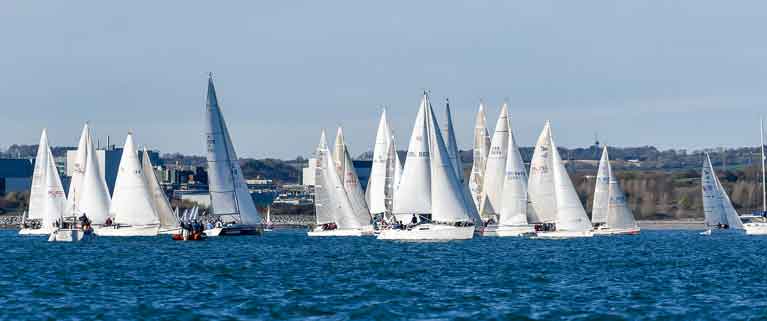 A wide range of different cruiser and sportboat types combine for all-in club racing. Photo: Bob Bateman
A wide range of different cruiser and sportboat types combine for all-in club racing. Photo: Bob Bateman
So how might this affect the future for ECHO in Ireland? The ‘elephant in the room’ and big consideration for the ISA and ICRA is that ECHO-type software programmes are now freely available and ideal for local club racing. Why then might a regional club or class need to use or pay for ECHO? It will naturally be conditional that the major regattas such as Volvo Dun Laoghaire and the ICRA Nationals insist on IRC and ECHO affiliation, but what for the local regattas when dinghies, powerboats and all sorts can use this software freely?
The current handicap registration process for cruiser racers in Ireland sees ICRA ‘pass the ball’ to the Irish Sailing Association to oversee the administration of IRC, ECHO and consequently the management of ICRA membership. With over 450 registered ‘member’ boats, ICRA really needs to take control of its own destiny. Their funding comes from an agreement with the ISA, who return a ‘slice’ of the revenues collected for racing certs (IRC and ECHO), after an administrative fee is deducted. A recent straw poll of the racing classes in Ireland would suggest that the average annual subscription for the various keelboat classes wanders between €50 and €100. One might imagine that a class that boasts about having thousands of participants should at the very least be able to raise €50-€100,000 of its own funds each year. But if there is danger in tagging their subscriptions through the ISA to an ECHO system that could now freely transfer to clubs and classes, and an IRC certification system that is already wary of international trends and new local interest towards ORC, then it’s time to think more creatively.
How might ICRA capture all cruiser-racing boats and add value where the ‘what’s-the-pointers’ need to be encouraged to participate in a national racing organisation? For instance, it’s possible that moves towards the national licensing and registering of vessels could provide an opportunistic inlet, although it would mean that the ISA would need to partly relinquish what would be its national governance – perhaps unlikely.
Taking control of a database-built results system might also afford ICRA (and other classes) to take responsibility for their members and racing administration – it would certainly help with sharing of performance handicap data and add value for clubs, classes and sailors. However, it has been suggested that the set-up cost would be prohibitive.
To survive as an organisation, ICRA must be an organisation – taking control of its own finances and of its own management of the Association.
The ICRA National Conference is being held in Castletroy, Limerick on Saturday and is themed ‘We must talk about cruiser racing’ and it’s certain that there will be lots of lively talk.
Brian Turvey
Royal Cork's Gibbons to Defend 2017 IRC European Title in Marseille
Royal Cork YC's Paul Gibbons, racing Quarter Tonner Anchor Challenge, who was the winner of the inaugural IRC European Champion Trophy last July, will be travelling to France this summer to defend his Euro title and the hope is other Irish IRC campaigners will make the journey to Marseille too.
After its inaugural outing at Cork Week 2016, Marseille is the venue for the 2017 IRC European Championship. The RORC championships will be organised by the Union Nationale pour la Course au Large (UNCL), the Cercle Nautique et Touristique du Lacydon (CNTL), the Societe Nautique de Marseille (SNM) and the Union Nautique Marseillaise (UNM), from the 5th to the 9th July 2017 in Marseille. A date that clashes unfortunately with Ireland's biggest regatta in Dun Laoghaire.
The French event was officially launched at the UNCL stand at Paris Boat Show, in the presence of the Presidents of the four organising clubs.
It will be the second edition of this international competition, after a first and successful one held in Cork Harbour in July 2016.
All the IRC rated boats, with a TCC equal or more than 0.900, are invited to participate to the Marseille 2017 IRC European Championship.
Crews from Belgium, France, Italy, Spain and United Kingdom, among others, have already announced their intention to participate in this new challenge, with Ireland's Gibbons declaring his intention to defend immediately on lifting the antique silver cup in Crosshaven.
Kinsale Sailing Cruisers Turnout for 'At Home' Regatta (PHOTO GALLERY)
There was a great turnout for Kinsale Yacht Club's 'At Home' Regatta yesterday. The all–in IRC 2016 cruiser fleet attracted 19 entries and was won by Richard Hanley's GK24 Saoirse. In a 41–boat ECHO handicap division the win went to an Elan 333, Artful Dodger, skippered by Finbarr O'Regan.
The main feature of this year's 'At Home' was the upsurge of new Oppie sailors who started sailing at KYC this season. Unfortunately, KYC’s sailability fleet was stood down due to a heavy airs forecast although some sailors later went to sea in a Hawk 20. During the day a large squall with rain went through and this put a lot of the beginner Oppy sailors out of action. KYC is suffering a shortage of cruiser racers, like many other clubs, and this was evident in the spinnaker class turnout. The Squibs mustered four boats but one retired before racing.Irish Crew Among the Prizes At RORC IRC Nationals
Irish crew were aboard one of the joint winners of today's RORC IRC championships on the Solent. This year's IRC National Championship, the 14th since the Royal Ocean Racing Club launched its handicap rule in 2000, had the unusual distinction of joint winners in Adam Gosling's brand new JPK 10.80 Yes! (winner of IRC Two) and the French consortium-owned A35, Dunkerque - Les Dunes de Flandre, (which topped IRC Three).
On board Gosling's IRC Two winner was Nicholas O'Leary of Royal Cork Yacht Club and pro–sailor James Hynes of Malahide. Last week's Round Ireland crewman on Phaedo3 Justin Slattery was racing on the stand-out team of Peter Morton's Girls on Film.
Full results here
Two Royal Cork boats were also competing in the Solent competition. Antix (Anthony O'Leary) in the Fast 40+ class and Jump Juice (Conor Phelan) in IRC one both placed sixth overall.
At the prizegiving Gosling thanked the RORC and the race committee; "It was pretty awesome racing considering the tricky conditions."
Benoit D'halluin, helmsman on the Dunkerque boat added: "We are very happy to race in Cowes and we had two good competitors in Bengal Magic and Intention." Dunkerque - Les Dunes de Flandre will return to Cowes in July with the Flanders North Sea team in the Brewin Dolphin Commodores' Cup.
"It was pretty awesome racing considering the tricky conditions"
Unlike stormy Saturday, on a slightly more serene Sunday the race management team was able to hold one windward-leeward in 8-15 knots winds. This was followed by two round the cans races in the central/eastern Solent, during which the wind built to 20+ knots, creating a short sharp chop from the building flood tide.
Stand-out performer of the day was the RORC's Admiral, Andrew McIrvine and his First 40, La Réponse, in IRC Two, which scored three bullets. However even this was not enough to topple Yes!
Gosling said he particularly enjoyed today's round the cans races. "We all had a smile on our face after the short A-sail reach, which the boat was just beautiful on, and then the 140° run when the wind got up to 20+ knots, which was fantastic."
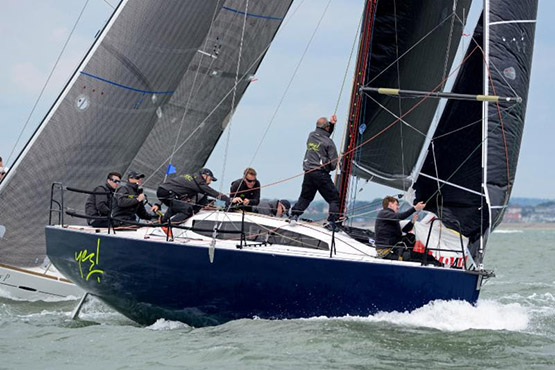
Adam Gosling's JPK 10.80, Yes!
As to their secret, Gosling said his crew have sailed together for years. "We are just trying to learn how to sail this boat, but each time we've gone out, we've sailed a bit better."
Conversely, the Dunkerque - Les Dunes de Flandre crew has been sailing their A35 for years. "We were happy to have good speed," said tactician Philippe Bourgeois. "It was really a pleasure to win the IRC Nationals. We only came here to practice for the Commodores' Cup."
New to the RORC IRC Nationals this year were the two box rule classes, the FAST40+ and the HP30. The most impressive display of the week came in the former, where the stand-out team was Peter Morton's Girls on Film. Aside from one fifth place finish, this Carkeek Mk3 was otherwise never off the podium, putting in a 2-1-3 today with American William Coates's Ker 43, Otra Vez and Irishman Anthony O'Leary's Ker 40, Antix, claiming the other two wins.
Ultimately, Girls on Film finished five points clear of Sir Keith Mills' Invictus. "We think we are fast, especially upwind and quick enough downwind," explained Morton. "In the last race, we bounced back from a pretty horrible start with pure speed. It always looks easy when you're fast." This wasn't entirely without incident, including a luffing match with Invictus after rounding the top mark in the final race that ended with Girls on Film taking a penalty turn.
As to why they have the edge, Morton continued: "It's a hundred little things and we have got a really strong crew - good amateurs and good pros. Our boat handling is pretty good."
Another stand-out performance of the week was that of former RORC Commodore Mike Greville and his Ker 39, Erivale III. Following his recent victory in the Morgan Cup to Dieppe, Greville and his crew have dominated IRC One at the IRC Nationals. Their 9.5 point lead over Rod Stuart and Bill Ram's Corby 37, Aurora, was the biggest margin across any of the five classes.
"We are definitely on a roll," agreed Greville. "We have got some new sails which helped, but we've had new sails before. I did put 10sqm on to the kite and that certainly helps on the downwind legs. The crew work went very well."
Today was one for the Jason Ker designs in IRC One. In addition to Erivale III, Irishman Conor Phelan's Ker 37, Jump Juice, claimed today's second race, while Andrew Williams' Ker 40, Keronimo, won the last race - encouraging in the build-up to her Commodores' Cup with the Israeli team.
After finishing last in the HP30 class during the Vice Admiral's Cup in May, John Reivers this weekend turned around his Melges 32 Drop Bear campaign to claim victory ahead of Malcolm Wootton's Farr 30, Pegasus.
American Lloyd Thornburg, best known as owner of the Phaedo Gunboat and MOD 70 multihulls was again campaigning his Farr 280 FOMO here, but finished third overall.
"It's meant to give us some closer racing," explained Thornburg. "We watched it at Cowes Week last year and we felt like we were missing out - so FOMO stands for 'Fear of missing out!' We are taking it more seriously than we thought. It was supposed to be a bit of a laugh..." FOMO's crew includes Olympic 470 silver medallists Nick Rogers and Stuart Bithell.
"The results are what they are, but we really enjoyed the racing," Thornburg continued. "We had a really good time."
Enhanced by the new box rule classes and this year's Brewin Dolphin Commodores' Cup, this year's IRC Nationals was among the most competitive on record with 61 boats taking part.
Cork Week Early Entry Discount Deadline Looms
With the early entry discount for Volvo Cork Week running out on May 1st Royal Cork Yacht Club organisers have been keen to point out innovations for the 2016 edition such as the first ever IRC European Championship and the Beaufort Cup as part of this summer's line–up.
'RCYC has always listened to competitors comments about Cork Week and has never been afraid to make improvements whenever possible', the club say in its latest mail out to competitors
Kieran O'Connell, Chairman of Volvo Cork Week, spoke candidly about the changes to this year's event, brought about by talking to competitors, the real cost of coming to Cork Week is being reduced by pro-active measures.
“When talking to people in Ireland and the UK." commented Kieran O'Connell. "We have been making a big effort to keep the cost down for visiting teams, we have been setting guide prices for local accommodation in Crosshaven and local home owners have been listening and reducing their expectations. For example a 3 bedroom house that sleeps 6 - 8 crew for the week is averaging at €1250 - €1500 or B&B for €50 per night. In 2016 there will also be camping options with toilet and shower facilities.
The committee have undertaken to keep food and beverage costs at normal club rates. Helly Hansen, the Official Clothing Partner to the event will have a retail shop in the regatta village, alongside other notable retailers such as CH Marine and Union Chandlery.
The entertainment line-up is fantastic this year with the event open to the public on Thursday and Friday nights with big name bands performing. The management team is putting a big effort into the apres-sail slot from 4.30 to 7pm, with live music creating the right sort of atmosphere, as the sailors come off the water.
The IRC European Championship is attracting new teams from overseas of a very high standard and the Beaufort Cup is bringing new faces to Volvo Cork Week. The Beaufort Cup invites sailing teams from their associated national services, 50% of each team must be active in the service they represent. Racing will take place over five days in a mix of offshore and inshore courses. The winning team of the Beaufort Cup will also have €10,000 donated to a nominated charity.
For yachts entering before the end of April, there is a prize draw for sailing gear and a weekend 40ft bareboat charter.
Including the one design 1720 and Viper Sportsboats, a wide variety of yachts have already entered Volvo Cork Week, with a significantly higher number of early entries compared to this time in 2014. For yachts entering before the 1st May 2016, there are two prize draws. Volvo Cork Week will be giving away, sailing gear and a weekend 40ft bareboat charter, kindly sponsored by Sovereign Sailing Kinsale.”
The early entry discount for Volvo Cork Week runs out on May 1st.
Royal Cork Yacht Club's Jump Juice (Conor Phelan) has won the 17–boat class two fleet of RORC's Easter Challenge on the Solent today in dramatic fashion. Clubmate Antix (Anthony O'Leary) at the helm of Antix was the winner of today's breezy FAST 40+ race but the Royal Cork yacht did not retain the overall trophy won in 2015 and finished fourth overall.
If traditionally the RORC Easter Challenge is the Royal Ocean Racing Club's coaching regatta, today's lesson centred upon heavy weather sailing technique.
As the fleet returned to yesterday's start area around Peel Bank, conditions were sunny and relatively benign, but with giant grey clouds looming. During today's one race, a squall stuck down the fleet with gale force gusts of up to 40 knots. In addition to numerous broaches, there were two man overboard incidents; one on James Neville's INO XXX racing in the FAST 40+ class, the other on RORC Admiral Andrew McIrvine's First 40, La Réponse.
On La Réponse the vang trimmer got washed overboard during a Chinese gybe. As McIrvine described it: "We were absolutely dead downwind and a little bit by the lee and a big gust took us the other way. We let the vang off too much and the boat rolled and we Chinesed in."
Fortunately the MOB's lifejacket inflated and they were recovered after a few minutes and hauled onto a RIB by RORC Commodore Michael Boyd and lead coach, Jim Saltonstall. The incident cost La Réponse victory in IRC Two, where today's race was claimed by former RORC Commodore Mike Greville on his Ker 39 Erivale III and the class prize went to Ireland's Conor Phelan and his Ker 37, Jump Juice.
Phelan described today: "We were happy to pull it off because the conditions were quite challenging." During the race they saw 35 knots. "I thought we were going to go down the mine on the run," said tactician Mike Budd. "We had to drop the kite and do two gybes at the bottom which was a bit wild but our main competitor [La Réponse] span out at that point which was bad luck to them because they sailed well."
With the big forecast, eight of the 10 FAST40+ class pitched up today but only four finished. While James Neville's INO XXX got away well at the pin, Mike Bartholomew's Tokoloshe II did well being first to hoist her kite. However the South Africans subsequently struggled to retrieve their kite causing it to fly like a flag from the masthead. Eventually the crew relinquished, performing a 'chase boat drop' with the assistance of RORC CEO Eddie Warden Owen.

Anthony O'Leary's Antix at full speed on the Solent this afternoon. Photo: Paul Wyeth
Today's FAST 40+ race was won by Anthony O'Leary's Ker 40, Antix. For the Irish two time Brewin Dolphin Commodores' Cup winner, this event was their first sailing this season. However O'Leary acknowledged that Antix prefers the big conditions. "Pound for pound, we sail better in a gale than in a calm." However, in similar conditions, they had finished fourth in yesterday's race. "We made some silly mistakes and you deserve to get punished for that. Our mark rounding was getting better as the weekend went on."
Ultimately Texan William Coates' Ker 43 Otra Vez was the overall winner of the FAST40+ class' first ever regatta. Peter Morton's Carkeek 40 Mk3 Girls on Film didn't compete today leaving Sir Keith Mills' Ker 40+ Invictus to take second overall.
Mills stated: "We saw 37 knots of wind and then various things started blowing away and we had a wonderful broach, when we nearly lost one of our guys over the side. We hit something like 23-24 knots downwind, but I had so much water in my face that I couldn't see the instruments. You need a snorkel and goggles! They are wet boats but such great fun to sail. My boat is like racing a dinghy."
Despite a strong challenge from David Franks' JPK 10.10 Strait Dealer, which claimed three bullets in five races, it was the newer, larger JPK 10.80 Sunrise that prevailed in IRC Three, winning today's race.
"This is the first time I have won a yacht race - which is why we're drinking at 1100!" enthused Sunrise's skipper, Tom Kneen. "We've only had the boat for four weeks and she's just astonishing - very very fast and in quite difficult conditions."
Kneen experienced his first Chinese gybe yesterday, but today calmed down, which he attributed to the coaching they received yesterday. "That was very useful - about moving our weight around the boat which makes such a difference. The whole process of this weekend has enabled us to build, so I am looking forward to the season."
In IRC Four Harry Heijst and his Winsome claimed today's race and the overall class win. The conditions over the Easter weekend perfectly suited the classic Dutch S&S 41. One of the most impressive performances in IRC Four was that of the Sam Laidlaw-helmed Quarter Tonner, Aguila. "It is a real handful and very hard to get uphill because you are almost overpowered," said Laidlaw of sailing the mini boat in the big wind. "It was gusting 35-38 knots, but we were planning at 16!"
Quarter Tonners aren't supposed to plane? "Someone forgot to tell the boat that! We got to the bottom of the run and all we could see was white water everywhere. We had a great time - great fun."
Racing Manager, Nick Elliott concluded: "While conditions were challenging over the regatta, this provided the perfect opportunity to gain valuable experience from our world class coaches and will certainly have jump started each participant's season."
Two Corby 25 IRC Racers For Sale on Afloat.ie
Have you ideas about purchasing the perfect IRC racer with occasional day cruising possibilities? Are you looking at a yacht with an overall length of 25 to 28–ft, to suit a crew of four or five? Are you working off a budget of somewhere between €30–40,000? Maybe you also want the possibility of sleeping on board for a lads weekend with fish and chips for supper? A focus point for your consideration then has to be the Corby 25 which offers so much more potential than a sportsboat. Afloat.ie boats for sale currently has two of these highly successful IRC designs listed for sale.
The Corby 25 is a fast sailing racing boat, it is built and designed to sail with great upwind performance. Corby 25s are typically of GRP hull construction, fitted with a fin keel and bulb and a spade rudder. Due to her relative high weight (2t) 50 % in the keel, the Corby 25 is very stiff, holding all sails up to 20–knots true wind, she reaches an apparent upwind angle of about 17 degrees and therefore has an ability to sail higher than most of her competitors.
These fractional sloops are also fitted with small saildrive inboard diesel engines.
Inside the Corby 25, there are typically four berths: two are under the cockpit and two in the central cabin. One toilet is installed in the front cabin. A flexible water tank is fixed to supply an outside shower with an electric pump. A maritime kitchen (one burner) on gimbals is available in option with an outside gas storage (EU norms).
The first of these listed on Afloat boats for sale is a 2004 version afloat in Cork. At €39,500 she is a previous winner of the ICRA 'Irish Boat of the Year' so has proven speed, according to Boatshed Ireland's Ken Lawless. Full advert here.
The second is a 2000 version an according to seller Liam Burke she is 'not your standard GRP production boat' but custom built by John Corby in the UK from Cedar strip and Epoxy making her lighter and stiffer than the subsequent production models'. At €29,500 this 2000 built boat had a hull respray in 2015. Full advert here.
The Empire Strikes Back: RORC Active on Two Fronts in Two Oceans
Sailing forums have seen exchanges in recent days about the relative global coverage of the Royal Ocean Racing Club’s (RORC) measurement system - the International Rating Certificate (IRC) - and the Offshore Racing Congress’s (ORC) Offshore Rating Certificate.
Dobbs Davis (US), the Chairman of the ORC’s Promotions & Development Committee, and Zoran Grubisa (Croatia), who heads the organisation’s Rating Officer Committee, were in Limerick three weeks ago at the Irish Cruiser Racer Association (ICRA) Annual Conference to make a presentation about their measurement organisation, its methods systems, and its level of world coverage.
This made available yet another fascinating nugget of top-level information for a wide-ranging conference which reflected the considerable influence the ICRA model has in international racing for boats with lids. And at the same time it ensured a good turnout to applaud the ICRA Boat of the Year title going to George Sisk’s WOW from Dun Laoghaire, and to witness the transfer of the role of ICRA Commodore from Nobby Reilly of Howth to Simon McGibney of Foynes. It’s the first time that ICRA has had a Commodore from the western seaboard since its foundation by Fintan Cairns of Dun Laoghaire and the late Jim Donegan of Cork in 2002.
Afloat.ie’s W M Nixon was in Limerick to take the pulse of this unique body, and his commentary in Sailing on Saturday of 12th March ruffled more than a few feathers, and greatly heightened interest in the RORC’s global programme, which has its European section swinging into action this weekend with the Easter Challenge on the Solent.
Who knows, but some time in the future it may be that Rory Staunton of Mayo Sailing Club will be remembered as the man who finally got the IRC and the ORC to get together by crisply pointing out - at the end of Dobbs Davis’s presentation to the ICRA conference - that as far as ordinary sailors were concerned, when IRC and ORC were both used in one event, the results often seemed very comparable. And while it was no harm some times to have two sets of winners (and even more if you include ICRA’s own Progressive ECHO system), at the top international level it only makes sense to Joe Public to have one undisputed winner in each class.
For the world promotion of offshore racing, the optics would surely be much better if everyone was racing to the same rating system? But it will take a while yet to reach this happy situation, for at the moment the ORC and the IRC appear to be in active competition, and regular visitors to the Afloat.ie website will be well aware that some very powerful voices have weighed in on the RORC/IRC side recently, going so far as to question the accuracy of the fleet numbers made in some ORC claims, and pointing to the IRC’s current areas of rapid expansion in southeast Asia and other regions.

Neil Pryde’s characterful Welbourn 52 Hi Fi won the Rolex RORC China Sea Race in 2012 and 2014
But actions speak louder than words, and this week sees the RORC hyper-busy in the Pacific with the biennial Rolex China Sea Race of 595 miles from Hong Kong to Manila in the Philippines, while on the eastern fringes of the Atlantic in the Solent at Cowes, there’s the annual Easter Challenge, an event with an approved integral training emphasis, as top coach Jim Saltonstall and his team will be buzzing through the fleet in their RIBs giving advice to those who have sought it.
With the Easter weekend’s all-too-evident weather deterioration in progress, it’s likely that yesterday will have given the fleet of fifty or so their pleasantest sailing conditions. But with the RORC secretariat decamped for the long weekend from world headquarters in St James’s in London to the club’s waterfront base in the Royal Corinthian YC in Cowes, a sense of being able to go home at the end of a hard day’s racing will ease the harshness of the conditions.
On the other hand, the fact that the RORC now has a bricks-and-mortar Cowes base in what was once the legendary Rosa Lewis’s “seaside cottage” will provide ammunition for those who would claim that the RORC, and the IRC with it, have essentially become a Solent-centric setup. Thus the fact that the Rolex China Sea Race under the RORC imprimatur is taking place at the same time is very helpful indeed for those who would promote IRC as the world’s measurement system.
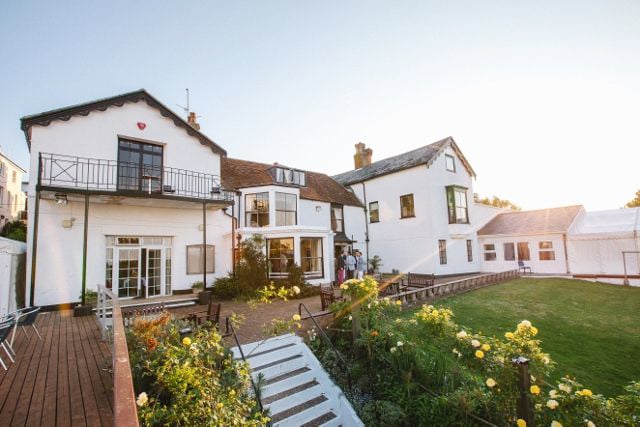
The nice little place by the seaside…..The Royal Corinthian YC in Cowes – a byword for hospitality – is now the RORC’s Solent base
In times past, leading Irish skippers with a Hong Kong base such as Paul Winkelmann and Jamie McWilliam have featured in the China Sea Race, for it has a history as a biennial event going back to 1962, when three yachts – one each from Hong Kong, the Philippines and Japan – raced this decidedly disputed bit of water. The situation was such that a naval vessel from Hong Kong accompanied them for the first two hundred miles, and then a hundred miles out from Manila, they were met by a ship from the Philipinnes navy.
The line honours and handicap winner was Chris von Sydow’s yawl Reverie, one of those classic American-style yawls of the Finisterre type which were being widely built in the region at the time, mostly for export. They were guaranteed as teak through and through, for as one sardonic observer put it, the wonderwood was so abundant out there in those days that if the team in the boatyard felt like a brew-up of tea, they’d boil their kettle on a little fire made with teak kindling.
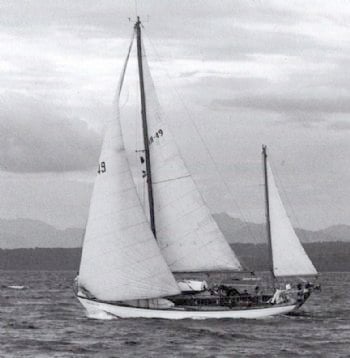
The winner of the first China Sea Race in 1962 was Chris von Sydow’s yawl Reverie
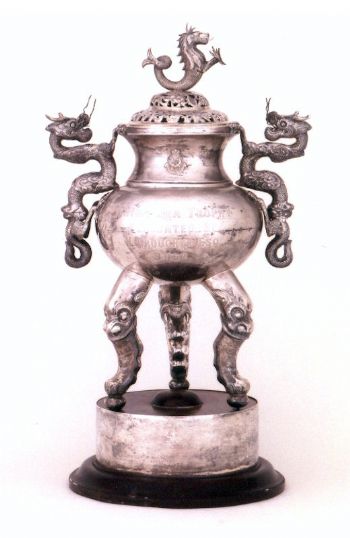
A trophy to match. Only a race right across the China Sea would merit a prize like this
Reverie’s time was four days 11 hours and 29 minutes, and she got the very distinctive China Sea Trophy, which is of such a style it just couldn’t be the prize for any other major offshore race. Gradually the numbers built up as it became an established biennial event, in 1972 the RORC came aboard as partners, and it hasn’t looked back since. There’s been some spectacular sailings, the record being set in 2000 by Karl Kwok’s Open 60 Beau Geste, which cracked the two day barrier by coming in on 47 hours and 43 minutes, just 17 minutes maybe, but it was 17 minutes the right way.
The races of 2012 and 2014 were won by Neil Pryde’s rather special Hugh Welbourn-designed 52 footer Hi Fi, but she’s not in this year’s fleet which got under way on Wednesday and has the front runners well in already, though only after a start in miserable conditions which improved in terms of sailing power to have a 28-knot nor’easter building in a monsoon. This made the going good the further you were down the course, but yesterday the little fellows at the tail end were taking a bit of a pasting.
Line honours were taken yesterday (Friday) evening by Australian Philip Turner’s Reichel Pugh 66 Alive, which covered 244 nm in the final 24 hours to set a new course record, though just 11 minutes inside Beau Geste’s remarkable 2000 time – who’d have thought it would stand for sixteen years? Overall on handicap, Alive currently also has it every which way, but things are also looking good for the Ker 42 Black Baza (Anthony Root).
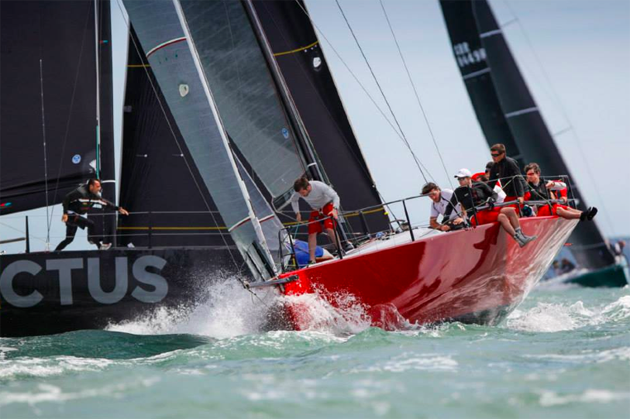
Cutting it close. Anthony O’Leary’s Antix in a neat-enough port-and-starboard situation with the even newer Ker 40 Invictus
Conditions in Manila may not be idyllic, but at least they’re a bit warmer than the Solent this morning with a succession of fronts set to sweep through for much of he remainder of the Easter Holiday. Irish interest is high as Anthony O’Leary’s Munster-red Ker 40 Antix is defending champion, and the skipper was in fine form in Thursday as he outlined prospects and talked us through some of the usual suspects who will be sailing on this very attractive boat.
Following his accident while racing Antix in ferocious conditions last July, it’s great news that Dylan Gannon of Howth is back on the strength, along with his shipmate Ross MacDonald who had a truly prodigious season in 2015, playing a leading role in crewing Antix while at the same time campaigning his family’s veteran X332 Equinox to such good effect that he was top boat at the ICRA Nats in Kinsale.
Back on the strength. Dylan Gannon (left) and Ross MacDonald are both sailing on Antix his weekend. Photo: W M Nixon
Two new additions to the Antix strength are Will Byrne from Howth, who was recently making the scene with Half Ton Classics World Champion Dave Cullen and the gang in the C & C 30 championship in Florida in January, and young Cian Guilfoyle from the National Yacht Club in Dun Laoghaire, who leapt to fame as the third man aboard the J/80 when Anthony O’Leary retained the Helmsman’s Championship of Ireland by a considerable margin at the NYC in October, with longtime shipmate Dan O’Grady the man in the middle.

Cian Guilfoyle maximising his righting moment while crewing for Anthony O’Leary in the victory in the Helmsmans Championship, October 2015. Photo: David O’Brien
Winning team. Cian Guilfoyle, Dan O’Grady and Anthony O’Leary in the NYC after winning the Helmsmans Championshjp 2015. This weekend, Guilfoyle has joined the crew of Antix. Photo: W M Nixon
The other top Irish contender in the RORC Easter Challenge is also from Cork, Conor Phelan’s Ker 36 (or is she a 37) Jump Juice of 2008 vintage. This makes her something of a veteran but she’s by no means the oldest boat competing, as one doughty skipper has turned up with a Mumm 36, which is like a bit of living history. Yet she’s in with as much of a shout as anyone else if the IRC is doing its work properly, which seems to be where we came in…….
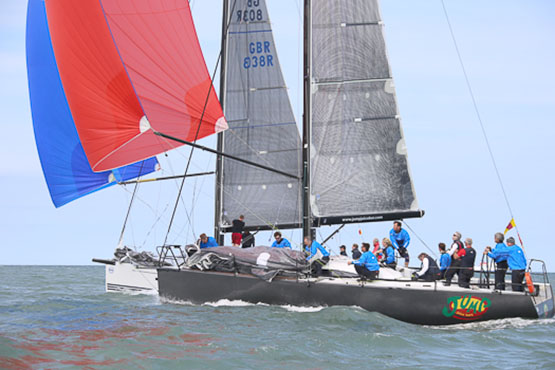
Back in the day…….the new Ker 36 Jump Juice makes her debut in 2008
But we cannot depart without musing on the makeup of this year’s Brewin Dolphin Commodore’s Cup team which will be defending for Ireland. As other people get agitated about the lack of heads above the parapet to indicate the beginnings of a buildup, Anthony O’Leary is reassuringly philosophical about the whole business.
He is of course very much up for it with Antix, and he’s well aware that there’s another good possibility with RORC Commodore Michael Boyd (Royal Irish YC) in line to be campaigning the works JPK 1080 as the season gets going, and of course the JPK 1080 is the boat du jour. As for a third boat, if Jump Juice is reluctant to make the commitment, they’ll be on the lookout for a boat rating 1.049 or above.
But it’s early days yet. As O’Leary recalls with quiet amusement, in assembling the 2014 team from scratch and the non-defence of 2012, he refused to let himself think that the new Ker 40 Catapult was a certainty until he actually saw her unloaded from a ship from America onto a quayside in Europe.
Yet she arrived on time. But it was the Steady Eddy of the team, the Grand Soleile 43 Quokka 8, which ended up causing the most concern. Her charter had been firmly in place since November 2013, but then there came a complete foul-up with delivery schedules back from campaigning in the Caribbean. It was more than a rush to have Quokka race ready for the preliminary jousting in Volvo Cork Week in July 2014. But not to worry. She ended up as champion in Cork Week, and made a solid contribution to the Commodore’s Cup win in which Catapult (which has since become Antix) was top-scoring individual boat.


























